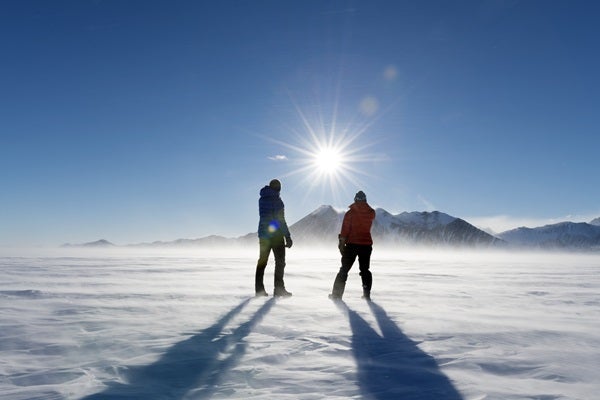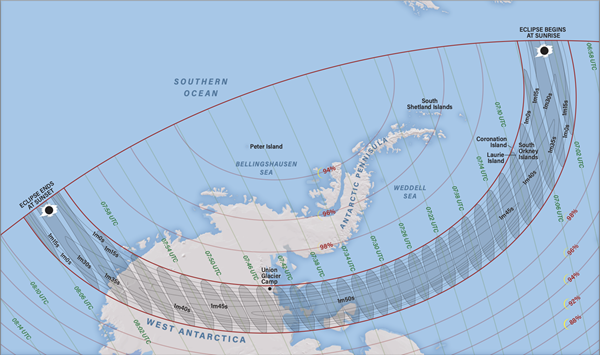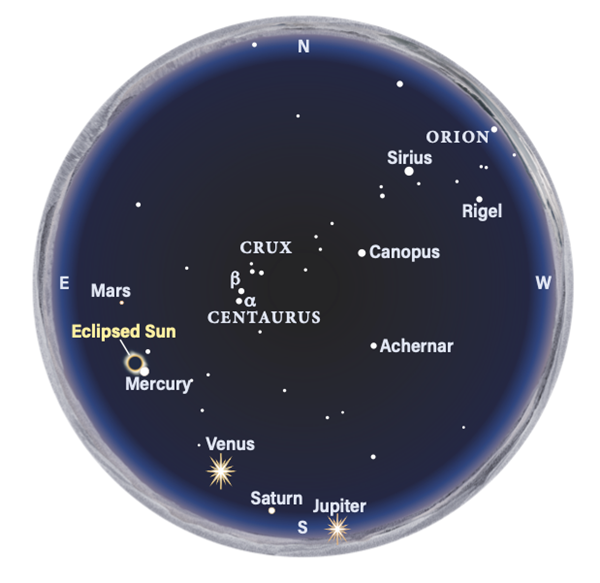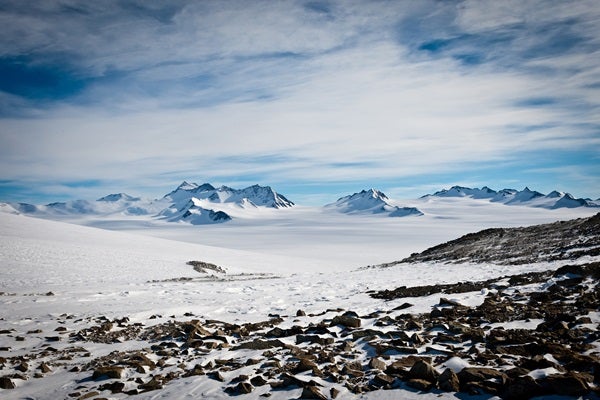On Dec. 4, a three-way celestial tango will once again occur as the Sun and the Moon line up with Earth to produce the greatest of nature’s spectacles: a total solar eclipse. And while many eclipses occur in faraway places, this one takes the cake. The darkest part of the Moon’s shadow during December’s eclipse will touch only the continent of Antarctica. So, pack your camera, your eclipse glasses, and your winter survival gear if you’re going to chase this event.
What’s going on
Total solar eclipses occur more often than total lunar ones, but more people have seen a total lunar eclipse (although the number of observed solar eclipses has been rising in recent years). The reason for the disparity is simple. During a lunar eclipse, anyone on the nightside of our planet under a clear sky can see the Moon passing through Earth’s shadow. Even at the Moon’s distance of about 238,000 miles (383,000 kilometers), that shadow is much larger than Luna. If the Moon passes through the center of our planet’s shadow, totality can last as long as 106 minutes — though it’s usually less because the Moon passes either above or below the shadow’s center.
On the other hand, the Moon’s diameter is a quarter of our planet’s, so its shadow barely reaches Earth’s surface to create solar eclipses. If you’re beneath the lighter, outer region of that shadow — called the penumbra — you’ll see a partial solar eclipse. As long as you’re wearing your eclipse glasses, a partial is nothing to scoff at, but there won’t really be any noticeable dimming of the Sun’s brilliance. The lucky individuals under the dark inner shadow — the umbra — will witness the daytime twilight of a total solar eclipse. Making that event even more dramatic is the fact that it doesn’t last long. Solar totality lasts a maximum of 7 minutes 29 seconds.
Unfortunately, an eclipse sporting that duration won’t occur until July 16, 2186. This December, the maximum duration of totality is 1 minute 54 seconds.
The path
The Moon’s penumbra first touches Earth at 12:29:11 A.M. EST (5h29m11s UT) and leaves its surface at 4:37:24 A.M. EST. The total phase of the eclipse begins at 2:00:01 A.M. EST some 217 miles (350 km) east of the Falkland Islands, at longitude 51°10’46” West and latitude 53°06’32” South.
The umbra remains in contact with Earth’s surface for 1 hour 6 minutes 28 seconds, until 3:06:29 A.M. EST. Finally, it vanishes 280 miles (450 km) north of the Antarctic coast at longitude 138°43’44” West and latitude 67°04’07” South. The total path length is 3,708 miles (5,968 km), which is relatively short. By comparison, the upcoming 2024 total solar eclipse that passes through the U.S. will sport a path length of 9,190 miles (14,790 km).
For this month’s eclipse, the Moon’s diameter will be 33’29”, while the Sun’s apparent span will be 32’27”. Astronomers call the ratio of the diameters of the Moon and the Sun an eclipse’s magnitude. The magnitude of this eclipse is 1.0367. Put another way, the Moon will appear 3.67 percent larger than the Sun. Greatest eclipse occurs at 2:33:23 A.M. EST at longitude 46°12′ West and latitude 76°47′ South, a point in the Weddell Sea just off the coast of Antarctica.
The sky during the eclipse
Both the Sun and Moon will lie in the southern part of the constellation Ophiuchus the Serpent-bearer. The Sun is in front of its stars from Nov. 29 through Dec. 17. At the moment of greatest eclipse, the Sun’s right ascension will be 16h43m32s and its declination will be –22°16’29”.
During the eclipse, the planet nearest to the Sun will be Mercury. The innermost planet, shining at magnitude –1.1, will lie 3° east-southeast of our daytime star. Sharp-eyed observers may spot it just outside the solar corona without optical aid. If you use binoculars during totality, they’ll guarantee that you’ll see Mercury. (Remember to use filters on your binoculars at any time other than totality.)
Venus, normally easy to spot during totality of any solar eclipse, may be invisible from its location 40° east of the Sun. That’s because the Sun’s maximum altitude during the eclipse is only 17°.
The shadow’s journey
The South Orkney Islands, which lie in the Southern Ocean some 375 miles (600 km) northeast of the Antarctic Peninsula, are where the Moon’s umbra first touches land. This small group is claimed by both Argentina and Great Britain but administered under the Antarctic Treaty System.
The western limit of the umbral path cuts through Coronation Island, the largest of the group, creating a partial eclipse for the western one-third of that small landmass. Laurie Island, which lies farthest east, fares better. The duration of totality on its western edge will be 57 seconds and will increase to 1 minute 7 seconds at its eastern coastline.
From there, the path treks southward more than 750 miles (1,200 km) to the northern coast of Antarctica. Just 44 miles (70 km) before it gets there, maximum eclipse occurs. Satellite and climate data show prospects for seeing the event improve the closer one gets to Antarctica, as December cloud cover is predicted at nearly 100 percent over the ocean path.
By far the best weather will be for those who can position themselves on the ice cap itself. Unfortunately, there is only one seasonal viewing site for explorers to use. Operated by Antarctic Logistics & Expeditions, this site is at Union Glacier, about 15 miles (25 km) inside the zone of totality. At the camp, the eclipsed Sun will be about 14° high and totality will last only 47 seconds, but weather prospects are better there than at any other easily approachable site along the path.
The eclipse comes during what should be nighttime hours at Union Glacier. But less than three weeks from the December solstice at the camp’s latitude of 79° South, daylight stretches 24 hours. Be careful to set up where the mountains surrounding your campsite won’t block your view.
Cruising to Antarctica
Getting to the southernmost continent can provide as much drama as the eclipse itself. Fortunately, the best months to travel to Antarctica are from November to March — the milder summer months in the Southern Hemisphere. Eclipse watchers heading there in early December will still see huge icebergs and pristine glaciers. Conditions are also optimal for viewing penguins, whales, and seals.
Most travelers start in Buenos Aires. From there, Aerolíneas Argentinas flies to Ushuaia, an Argentinian settlement on South America’s southern tip, where most cruises depart. Travelers could arrive a day or two before their ship sails to stay at Arakur Ushuaia Resort & Spa — the world’s most southern luxury lodge — and join a day trip to the nearby Tierra del Fuego National Park. Some Antarctic expeditions depart from Hobart, the capital of Tasmania, as well as Invercargill and Bluff, which lie on the southern coast of New Zealand’s South Island. This route is for the eclipse watcher with a bit more time, as the journey takes seven days.
Boats take two days to cross the Drake Passage and stop in the South Shetland Islands to explore the Antarctic Peninsula from the Weddell Sea to Gerlache Strait. One thing to keep in mind, particularly for those who suffer from seasickness, is that the Drake Passage (Mar de Hoces), which lies between Cape Horn and the South Shetland Islands, is one of the world’s roughest stretches of sea. Ships use it, however, because it’s the shortest crossing between Antarctica and any other landmass.
Astronomy’s tour
For this eclipse, Astronomy magazine is once again working with TravelQuest International. In partnership with Antarctic Logistics & Expeditions, TravelQuest has created a unique expedition culminating in 44 seconds of darkness as the Moon’s shadow passes over a vast expanse of ice and snow.
Instead of cruising across potentially rough waters, guests will embark on a privately chartered flight to TravelQuest’s private, fully equipped camp deep in the Antarctic interior. There, travelers will spend six nights and enjoy not only organized daily activities tailored to the weather and their interests, but a special viewing of the eclipse from a site near camp. For more information, visit travelquesttours.com.
Those of you heading to Antarctica for the eclipse will create a memory that will last a lifetime. And you won’t have another opportunity like this for a while: The next total solar eclipse to touch the frozen continent occurs Dec. 15, 2039.













